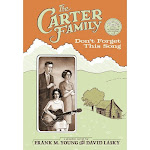Many people look at the credits to the book: “by Frank M.
Young and David Lasky” and assume that Frank wrote the story and I did
everything else. The real story of how
the graphic novel came to be is so much more complicated that I think it
deserves an explanation here.
Frank and I had a very evenly divided partnership, which is
a little unusual for comics, where often the writer turns in a script and
leaves the artists to do the larger share of the labor. Because I have writing skills, we co-plotted
the story (which was based on real life events) and created a
chapter-by-chapter outline together. Because Frank has drawing and computer
graphics skills, he was able to draw half the thumbnails with me, and color the
entire book (except for a handful of pages I colored, based on Frank’s guides,
and a few that Jim Gill colored). Frank’s
coloring, which evokes 1930s comic strips, does so much to enliven and unify
the pages, I considered it the most important visual element in the book.
I drew the print-sized rough draft of the book (with Frank
helping out on a chapter), and at the same time, Frank began to write dialogue
based on how much space was available. Frank would later go back and revise all
of the dialogue. In the thumbnail and rough stages, we also did a lot of
editing together, to make sure the story moved along at a good pace and had all
the information we wanted to include.
When the whole book was roughed out, I then penciled and
inked all of the oversized finished art (with help on many of the pages from
background inkers Sean Michael Robinson and Carl Nelson, with additional
support from Tom Dougherty, Dalton Webb, and Vince Aparo). As soon as I would finish inking a batch of
pages, Frank would scan and color them. He would also lay out the pages and add
my letters to the word ballons in InDesign.
From there, the fantastic design team at Abrams ComicArts prepared the
pages to go to press. Our editor, Charles Kochman, who was checking in with us
over the course of the project, gave the text a thorough edit before it went to
press.
Because this was a historical book, we both did research,
often at the same time as the book was being written and drawn. Historical facts had to be checked for
accuracy. Visual elements had to look
right for the era being depicted. At one time, Frank had worked as a
journalist, and brought those skills to the book, conducting several phone
interviews with scholars and relatives of the Carters and Peers. We also
managed to track down some important archival interviews. My friend Susan spent a weekend researching
at an archive in Chapel Hill, NC for us. And in one crucial act of research,
Frank tracked down some public domain sheet music that allowed us to use a good
portion of lyrics that were important to the story -- without fear of copyright
infringement.
There was no easy way to say who did what, which is why you
see the simple credit: “by Frank M. Young and David Lasky.” It was a true
collaboration, where we accomplished something that neither of us could have
done on our own.





